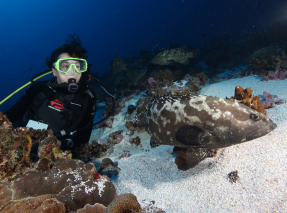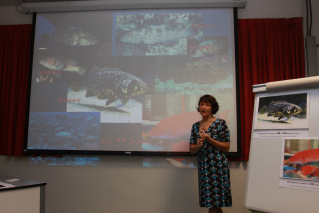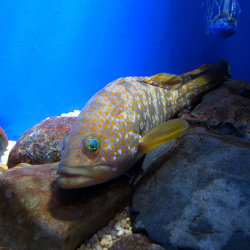Media
A billion-dollar business puts grouper species and people
in the trade at risk
HKU- led research finds over one-tenth of groupers of at least
20 popular species facing extinction from overfishing and illegal trade
21 May 2013
At least 20 popular species of groupers accounting for twelve percent of the fish are facing extinction, putting the livelihoods of hundreds of thousands of people around the world at risk, finds a report published in academic journal Fish and Fisheries on April 28, 2013.
The study, led by Professor Yvonne Sadovy, an expert in marine and freshwater biology of the University of Hong Kong (HKU), is based on data accumulated by experts over a period of 20 years.
Most of these threatened species are food fish found frequently on dinner table in luxury restaurants of Hong Kong. They include the humpback, high fin or mouse, grouper (Cromileptes altivelis), Hong Kong or red grouper (Epinephelus akaara), longtooth grouper, (Epinephelus bruneus), blacksaddled coralgrouper (Plectropomus laevis) and the giant grouper (Epinephelus lanceolatus). An additional 22 species (13%) are considered to be near-threatened including the popular leopard coral trout (Plectropomus leopardus) and camouflage grouper (Epinephelus polyphekadion).
The overall percentage of threatened groupers could be higher as there is insufficient data for about thirty percent of the species, according to The International Union for Conservation of Nature (IUCN) Red List of Threatened Species™.
Overfishing and the booming international luxury seafood trade have been identified as major threats to the survival of some grouper species, and to the livelihoods of those who depend on them for food and income.
“Most of them are not managed at all and their natural ability to reproduce can’t keep up with increasing demand. The rapidly growing international trade in groupers further reduces their populations,” said Professor Sadovy, who describes the declines in some grouper fisheries as alarming. Professor Sadovy is also Co-Chair of the IUCN SSC Grouper and Wrasse Specialist Group.
More than 300,000 tons of groupers – or 90 million individuals – were caught globally in 2009, mostly in Asia, where they are particularly sought-after for the luxury restaurant trade. Groupers are the foundation of the US$ 750 million international live reef fish market centered in Hong Kong and growing in mainland China, where consumers are ready to pay over US$ 200 per kilogram of the species.
Groupers are also important food fish in developing countries like Indonesia and the Philippines, where pressure to export reef fish is growing.The massive trade in live reef fishes, which is spreading and growing in Mainland China, is seriously contributing to overfishing in Southeast Asia, particularly the Philippines, Malaysia and Indonesia and previously in some countries of the western Pacific such as Fiji and Palau, both of which have now banned the trade.
“If we are to enjoy wild reef fishes in the future, their populations must be managed, trade must be controlled to within biologically sustainable limits, and customers not only be prepared to pay more for such fish but also to eat them less often.” Professor Sadovy said exporting countries will have to manage their fisheries carefully and importing countries, like Hong Kong, can help them by monitoring the import trade and enforcing laws that protect threatened species.
HK is an important global trade centre for groupers. Regulations here however are outdated and fail to comply with international convention and agreements. Instances of illegal trade are quite frequently noted.
“As just one example, one fish in the live reef fish trade of Hong Kong is the Humphead wrasse (or Napoleon fish), Cheilinus undulatus (So Mei in Cantonese). This is protected under international legislation on Appendix II of CITES (Convention on International Trade in Endangered Species) but fish continue to enter (and exit into the massive market of Mainland China) the city illegally mainly because there is inadequate inspection of Hong Kong-registered vessels that carry live seafood,” said Professor Sadovy.
Meanwhile, mariculture, or fish farming, offers only a limited solution to overfishing and seafood supply, as farming groupers very often involves grow-out in floating cages of juvenile groupers caught in the wild, hence taking too may juveniles of species which will eventually lead to their disappearance. Professor Sadovy said the ultimate solution should be a change in the eating habit, particularly of the Chinese people, who favour the wide species and whose consumption of groupers is on a rapid rising trend.
She also urges the Hong Kong government to step up measures to combat illegal trade and to promote sustainably sourcing and marketing practices and policies for conservation of the species. Her suggestions below:
- Source countries need to manage fishing levels for local food security as a top priority with exporting their reef fishes only carried out if resources are sufficient.
- Hong Kong and Mainland China governments must monitor international seafood trade, especially by ships, to ensure compliance with international Conventions such as CITES for threatened species and to assist in monitoring volumes of trade by species and their provenance. Such information is essential for enforcement and for following trade trends and changes over time, as well as for food safety considerations.
- Hong Kong government needs to update its regulations to bring live fish trade under better control; live fish is unregulated, unlike dead fish which must be marketed through the Fishery Marketing Organization. There are historic reasons for this but these are now very much out of date and consistency and rigour is needed in the seafood markets and trade for health and sustainability reasons.
- Traders and retail outlets can contribute significantly to the supply of sustainably caught fish to consumers by their sourcing and marketing practices and policies, and in relation to Corporate Social Responsibility practices. One option is to develop and promote trade relationships with responsible producers.
- Shipping companies could be more vigilant to ensure that they are not transporting illegal cargo.
- The local mariculture sector could adopt better practices by feeding groupers with pellet food rather than wild ‘trash’ fish and by only importing hatchery produced juveniles, not wild caught juveniles, for grow-out operations.
- Customers can exercise options to select sustainably sourced seafood using the WWF Seafood Guide, or Marine Stewardship Council labeled fish in our shops and markets.
- An informed public is well-positioned to make good seafood choices; education in all sectors of the public on the importance of consumer choice and the state of our oceans is needed. The government should set a good example by serving sustainably caught seafood in official functions
- Many people still believe that the seas are endlessly full of fish and have no idea where the fish on their plate comes from. It will need to develop a better understanding in the city about the impacts that one’s habits have on other places in the world.
The article “Fishing groupers towards extinction: a global assessment of threats and extinction risks in a billion dollar fishery” is available at: http://onlinelibrary.wiley.com/doi/10.1111/j.1467-2979.2011.00455.x/abstract
For a short video taken by Professor Sadovy The Spawning for Survival, please visit: http://www.cpao.hku.hk/media/groupers.mp4 (music of the video is copyrighted)
About IUCN
IUCN, International Union for Conservation of Nature, helps the world find pragmatic solutions to our most pressing environment and development challenges. IUCN supports scientific research, manages field projects all over the world, and brings governments, NGOs, the UN and companies together to develop policy, laws and best practice. IUCN is the world’s oldest and largest global environmental organization, with more than 1,000 government and NGO members and almost 11,000 volunteer experts in some 160 countries. IUCN’s work is supported by over 1,000 staff in 60 offices and hundreds of partners in public, NGO and private sectors around the world. www.iucn.org; IUCN on Facebook; IUCN on Twitter
About the Species Survival Commission
The Species Survival Commission (SSC) is the largest of IUCN’s six volunteer commissions with a global membership of around 8,000 experts. SSC advises IUCN and its members on the wide range of technical and scientific aspects of species conservation, and is dedicated to securing a future for biodiversity. SSC has significant input into the international agreements dealing with biodiversity conservation.
The IUCN Grouper/Wrasse Specialist Group was established in 1998/9. The Mission of group is to promote the conservation, management and wise use of groupers and wrasses, and to enhance awareness of the vulnerability of this group of fishes, and of the habitats upon which they depend. The Specialist Group in the current triennium has 40 members from 18 countries.
For enquiries about the research, please contact Professor Yvonne Sadovy, Professor, School of Biological Sciences and Swire Institute of Marine Science, HKU, email: yjsadovy@hku.hk; or office phone: 2299 0603
For media enquiries, please contact Communications and Public Affairs Office: Assistant Director (Media) Ms Trinni Choy, tel: 2859 2606 email: pychoy@hku.hk, or Senior Manager (Media) Ms Melanie Wan, tel: 2859 2600 email: melwkwan@hku.hk.



